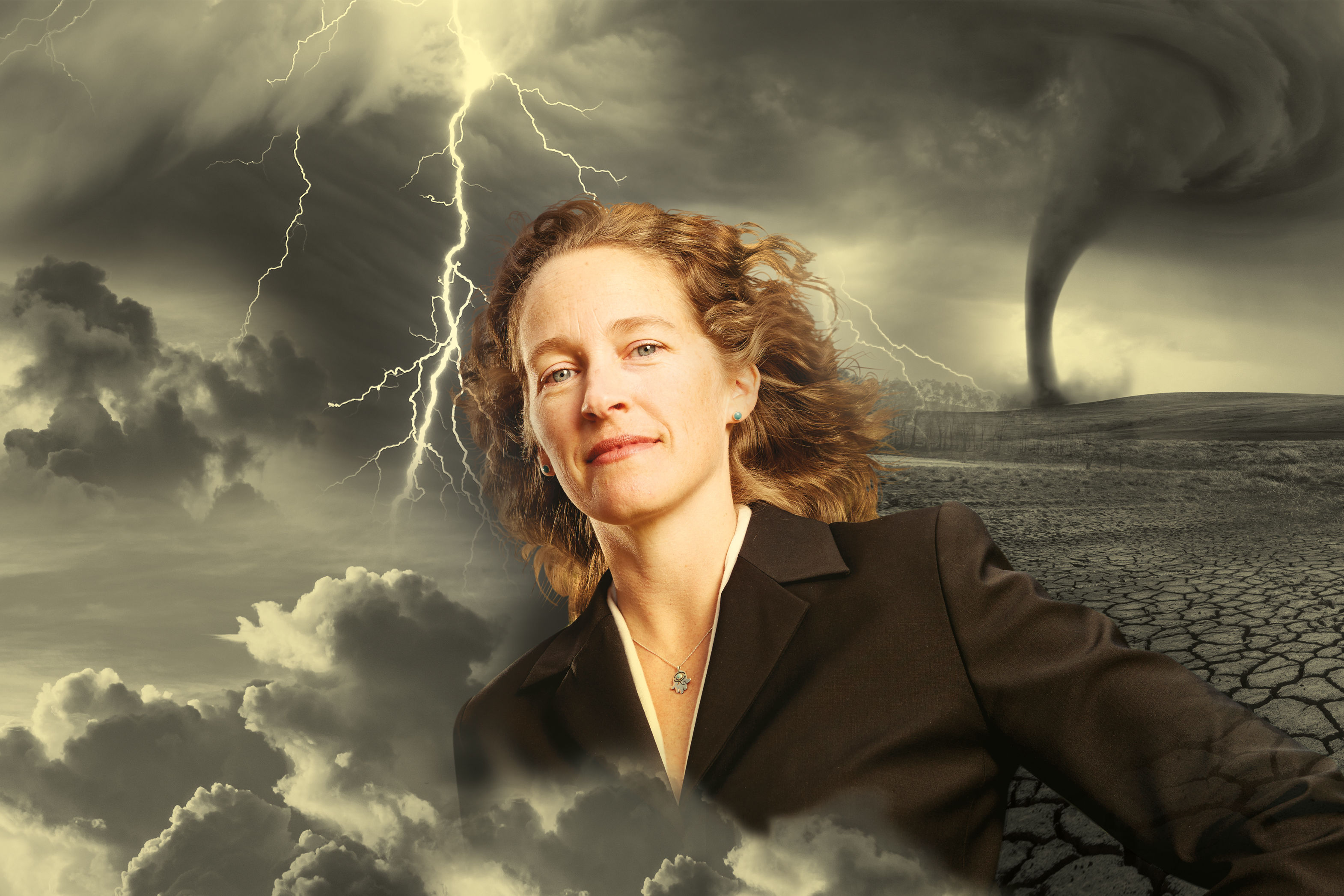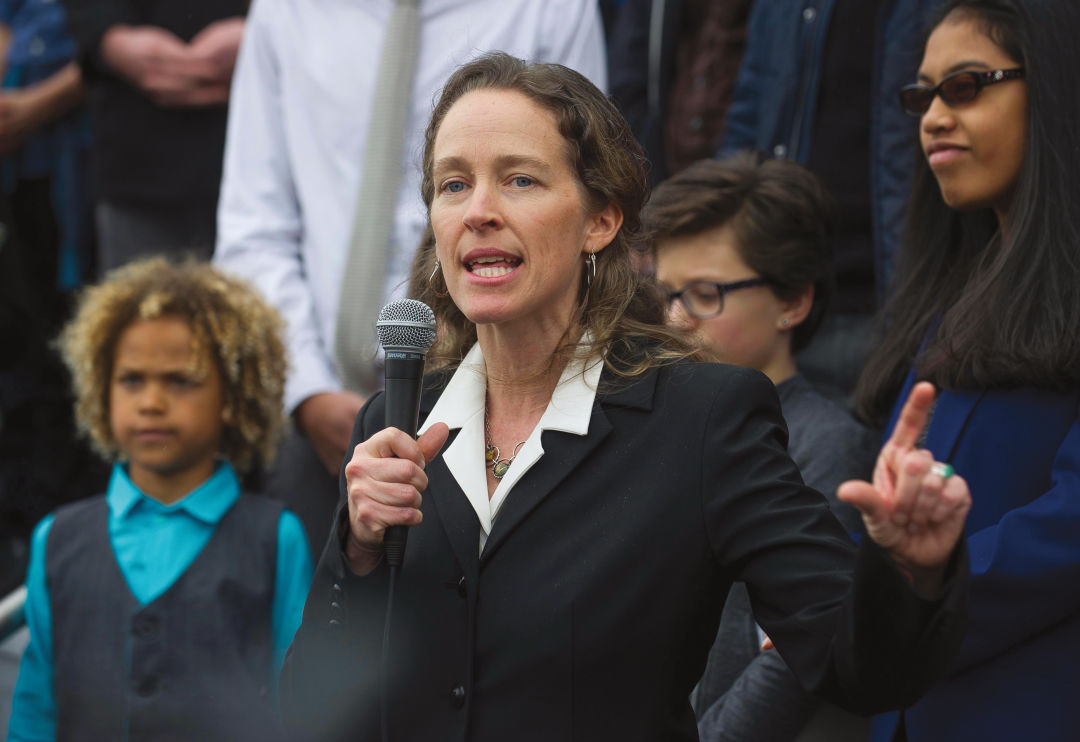
Meet the Oregon Attorney Suing President Trump over Climate Change
In a converted blue house with white trim on Lincoln Street in downtown Eugene, attorney Julia Olson and two colleagues unfurl a stretch of butcher paper longer than they are tall. It’s a timeline, marked up with red, green, blue, and purple markers. Taped to a wall, it resembles a high school history project. Huddled around computers and two dozen books, Olson, Elizabeth Brown, and Nate Bellinger could be students cramming for a big test. The timeline starts in 1771. Today, they’re studying 1983.
“Facilities may face great hazards and have shorter lives,” Olson says, paraphrasing from an Environmental Protection Agency report on sea level rise. “Nice of them to admit that in ’83 and then ignore it.” Brown picks up the thread.
“Global sea level will almost certainly rise in coming decades,” she reads, adding, “and they predicted seven feet by 2100 is most likely.”
A few minutes later, Olson scribbles something on the butcher paper. They work for about an hour, thumbing through books with titles like The Future of American Oil and Merchants of Doubt, calling out tidbits they unearth as they go. Every once in a while they laugh, but in that head-shaking, can-you-believe-this way.
Olson and her colleagues at the legal nonprofit Our Children’s Trust are waging one of the most ambitious environmental law cases in history: suing the federal government over policies and actions they claim have furthered climate change. Along with prominent climate scientists, such as James Hansen, the plaintiffs include 21 children and young adults drawn from across the US, a generation that will eventually bear the brunt of global warming.
The timeline (check out key moments here) is at the heart of their case, in which President Donald Trump and numerous federal agencies, like the EPA, are defendants. The butcher paper scroll aims to show what the government knew about climate change, starting before George Washington took office, and what officials did about it. For each point, the timeline notes the commander-in-chief and atmospheric carbon dioxide levels (a heat-trapping gas) in parts per million. During the ice ages, CO2 levels were around 200 parts per million. When Washington took the oath of office in 1789, they were about 280 ppm. By the end of Grover Cleveland’s presidency about a century later, levels approached 300 ppm. In 1903, President Teddy Roosevelt urged Americans to steward the environment, so that their grandchildren could benefit from it. “We have gotten past the stage,” he said, “when we are to be pardoned if we treat any part of our country as something to be skinned for two or three years for the use of the present generation, whether it is the forest, the water, the scenery.”
The burning of fossil fuels over the past century has increased the concentration of greenhouse gases in the atmosphere, and in 2013, CO2 levels topped 400 ppm for the first time. In Juliana v. United States, which Olson filed in a Eugene federal court in 2015 on behalf of plaintiffs then ages 8 to 19, she and her team argue that the government violated kids’ right to due process by promoting fossil fuel consumption. The suit—which takes its name from plaintiff Kelsey Cascadia Rose Juliana—asks the court to mandate the government prepare and implement a national plan to phase out fossil fuel emissions and draw down excess atmospheric CO2. The courts would monitor and enforce compliance.
Fundamentally, Juliana argues that today’s children and future generations have a right to a livable climate—and the life, liberty, and property such a climate would sustain—and that the government is violating that right.
When Olson and her team filed their lawsuit, Barack Obama was president, the Paris climate agreement was in the works, and the US federal government had adopted a policy to curb greenhouse emissions, even if many environmentalists and scientists found it inadequate. Now, of course, the president is Trump, who once called global warming a Chinese-orchestrated hoax and in June announced US withdrawal from the Paris agreement. His EPA administrator, Scott Pruitt, has spent his political career fighting environmental regulations. The new administration is expected to eliminate the Clean Power Plan, crafted under Obama’s EPA to curb carbon from electricity generation.
Meanwhile, the case—contrary to many expectations—has advanced to trial, currently scheduled for February 2018, with Obama replaced as lead defendant by a president who called climate change “bullshit.” (The White House and the Department of Justice did not respond to queries for this story.) The case could drag on for years and proceed through the court system; in July, the Ninth Circuit Court of Appeals issued a ruling on a Trump administration petition that could delay the trial.
Today, however, Olson and her team focus on the timeline: a document not so much of denial, but indifference. By noon they’re ready to move on to the next year: 1984.

Julia Olson speaks on the steps of the federal courthouse in Eugene after one preliminary step in Juliana's journey through the judicial system.
After lunch, Julia Olson gets on her bike and pedals to meet her kids before heading home.
Her red, cheerful 1920s house bears a front-door sign that’s appeared on many others around the country: In this house, we believe: Black Lives Matter ... science is real ... kindness is everything. Sheet music for John Lennon’s “Imagine” is propped up on the piano, and Blue, the family dog, greets Olson and her two boys as they walk in. Olson heads to the kitchen to cut orange slices. Just back from a week in Berkeley, she asks about homework and gently chides the kids to wash their hands before their snack.
In court, she wears a suit, but in the office and now back home she’s in jeans, her wavy brown hair loose around her shoulders. Gathering celery, peanut butter, and raisins to make ants on a log, she listens carefully to her kids and patiently tells the younger one—a few times—why he can’t go to a friend’s house that afternoon. She gives the impression that she’s always paying attention, assessing, deciding, as she peers across the table with pale blue eyes and a serious expression. But with her petite build, soft voice, and mild demeanor, it’s not hard to imagine she’s been underestimated, too.
Olson grew up in Colorado Springs, before that mountain town became synonymous with Focus on the Family and right-wing politics. She studied international affairs at the University of Colorado in Boulder and became a self-described ski bum, albeit one who did well on the LSAT. In 1997, she earned her law degree from the University of California–Hastings.
Olson landed at the environmental law nonprofit Earthjustice and eventually opened her own practice, representing smaller, grassroots groups in cases concerning public land, parks, and the Endangered Species Act. In 2006, when she was eight months pregnant with her second son, she watched Al Gore’s famed climate change documentary, An Inconvenient Truth.
“I was kind of overwhelmed by the emotion of it all, and the world we’re bringing kids into,” she recalls. She launched Our Children’s Trust from her house, leaning on law students and recent graduates from the University of Oregon. Money was tight—“we went without pay,” Olson says—but she was ultimately able to hire her first two full-time employees. Even so, Juliana will cost an estimated $1.5 million before trial, and it has been difficult to convince the foundations that often fund nonprofit legal causes that a stable climate is a constitutional right.
Before a weekly staff meeting in the spring, Olson and a few colleagues discuss the cheapest way to get kombucha on tap in the office—“I’ve got a little bit of a kombucha addiction,” she admits—and strategize about how to amplify the message of their mission to a growing audience. Eventually, everyone in the room puts their cellphones in a jar on the conference table, and the faces of staffers who work remotely start appearing on a screen as they connect with their counterparts in Eugene. The team takes turns reporting their feelings.
A theme emerges: tired. Elizabeth Brown stayed up late to finish her taxes; Nate Bellinger spent the weekend ripping out his lawn. Olson tells of running in the rain the night before, a recess from consuming work. “I have way too much to do that’s impossible to complete,” she says to the group. “But one day at a time.”
The legal strategy behind Olson’s case owes to her long acquaintance with a University of Oregon law professor named Mary Wood. Wood, who directs the school’s Environmental and Natural Resources Law Center, taught environmental law for decades, slowly but surely becoming disenchanted with that field’s actual practice. The professor recalls thinking, as Hurricane Katrina pummeled New Orleans in 2005, We’re never going to solve the problems of climate change and sea level rise in time.
Wood began considering what legal theories could serve environmental lawyers better than the statutory law, such as the Clean Air Act, they typically relied upon. She landed on “public trust doctrine,” a principle that dates to the Roman Empire and holds governments responsible as trustees of public resources they must protect for future generations.
“What could be more crucial than the atmosphere?” Wood says.
She began developing a strategy she called “atmospheric trust litigation”: lawsuits that would cite public trust doctrine to hold government accountable for the climate crisis and force reductions in carbon dioxide emissions. Only problem was, Wood wasn’t a litigator. But Olson was.
There is a model for the litigatory strategy they devised, albeit a distant one: An attorney in the Philippines sued that country’s environmental ministry on behalf of children, challenging the logging of the last ancient forest there. And, in 1993, he won. Wood envisioned multiple cases like it, filed simultaneously around the United States. Starting in 2011, that’s what happened. Our Children’s Trust helped young clients file separate petitions or lawsuits in every state in the country, seeking science-based plans to reduce carbon dioxide emissions. Wood has organized and submitted briefs supporting them in many of the suits. Judges have dismissed some cases; others are still pending or have prevailed. But these days, Our Children’s Trust is after a bigger adversary.
On August 12, 2015, the nonprofit sued the federal government. In November 2016, two days after Trump was elected, US District Court Judge Ann Aiken rejected the Obama administration’s motion to dismiss the case. To Wood, that preliminary decision indicates the court actually understands the reality of climate change. It surprised others. Jonathan Cannon, director of the environmental and land use law program at the University of Virginia, called it a “significant step in the existing judicial doctrine to the climate change problem.”
“Cases like this are brave attempts to reform or extend the legal system into new areas, so it’s innovative and risky at the same time,” he says.
The prospect that a judge could rule the government is cheating kids on the climate, as unlikely as that might ultimately be, leaves others wary. Jonathan Adler, a law professor at Case Western Reserve University in Cleveland, doesn’t think it’s the courts’ role to force change when, for example, a federal agency like the EPA simply isn’t using its existing authority to regulate greenhouse gases. There’s nothing in the law that requires the federal government to exercise that power, he says, even if there should be.
“I think climate change is a serious problem that I’d like the Trump administration and Congress to take seriously,” he says. “But I’m not particularly sympathetic to the idea that it’s appropriate for courts to inject themselves based on a feeling that the political branches aren’t doing what courts feel they should be doing.”
And consider this, Adler added: A successful Juliana v. United States would imply that judges can rule the government is abandoning its obligation to future generations. If Trump is president for two terms, he’ll likely nominate a significant percentage of federal judges in the United States. If Juliana sets a precedent, what might future Trump-inflected courts tell governments to do?
It’s too early to say whether Juliana v. United States will lead to new, effective regulations to curb greenhouse gas emissions. But the publicity campaign is certainly a success. Media outlets from around the world have reported on the lawsuit. Online, you can “join the movement” on Our Children’s Trust’s website, and the organization is active on social media (#youthvgov). Olson and her team worry over the colors to use on banners for public appearances and whether the Our Children’s Trust logo will appear. There are photo ops in front of formidable statehouses and courts. Many of the plaintiffs involved in the lawsuit flew to Washington, DC, in April for the March for Science.
Wood likened the campaign to fights for civil rights or gay marriage. “It inspires people,” she said. “Above all, it just makes common sense.”
For those worried about how the climate will fare under the Trump administration, this case has been a source of hope. “People are looking for ways, for avenues, to address that, and here the court has opened the door at least a crack,” Cannon says.
Levi Draheim, the youngest of the plaintiffs, is looking toward the future, when he and his peers will confront the consequences of choices made by earlier generations. “They won’t even be here when it’s the worst,” he told me last year. Draheim, who turned 10 in July, lives on a barrier island in Florida. Mostly people are supportive, but by now he’s encountered adults who are skeptical of the case, or don’t take him and the other plaintiffs seriously.
“Maybe they think kids aren’t smart enough to know that much about the environment,” he said. “But kids spend a lot more time outside.”
Julia Olson is worried about Trump’s environmental policies. But she also sees a longer saga of neglect: she blames Obama, Clinton, the Bushes—even Jimmy Carter. “Every president that preceded did something that made climate change worse,” she says. “It’s not helpful to rewrite history.” She and her colleagues—and the kids at the center of this audacious case—hope, instead, to rewrite the future.




